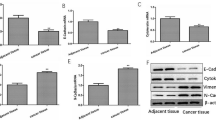Abstract
Glioblastoma (GBM) represents one of most common tumors in humans. However, the biological processes and molecular mechanisms of GBM are still unclear. It is known that microRNA-520b (miR-520b) participates in the development of various tumor progressions. The present study was to evaluate the level of miR-520b in GBM tissues and cells. We further investigated the molecular mechanisms of miR-520b in U87 and U251 cell lines. Here, our data showed that the expression levels of miR-520b were significantly reduced in clinical GBM tissues and cell lines. Accordingly, the expression levels of cyclin D1 were significantly increased in clinical GBM tissues and cell lines. Ectopic expression of miR-520b in U87 and U251 cells resulted in decreased cell proliferation and enhanced cell apoptosis. Further study characterized the 3′ untranslated region (3′-UTR) of cyclin D1 gene as a direct target of miR-520b in U87 and U251 cells as determined by luciferase reporter assays. In addition, ectopic expression of miR-520b led to the down-regulation of phosphorylated retinoblastoma (p-Rb, a downstream effector of cyclin D1), while the overexpression of cyclin D1 reversed the miR-520b-induced inhibition of p-Rb expression. In conclusion, this study highlights the importance of miR-520b in regulating the proliferation and apoptosis of GBM by directly targeting cyclin D1, and miR-520b may represent a potential therapeutic strategy for GBM.





Similar content being viewed by others
References
Louis DN, Ohgaki H, Wiestler OD, Cavenee WK, Burger PC, Jouvet A, et al. The 2007 WHO classification of tumours of the central nervous system. Acta Neuropathol. 2007;114(2):97–109.
Meis JM, Martz KL, Nelson JS. Mixed glioblastoma multiforme and sarcoma: a clinicopathologic study of 26 radiation therapy oncology group cases. Cancer. 1991;67:2342–9.
Galanis E, Buckner JC, Dinapoli RP, Scheithauer BW, Jenkins RB, Wang CH, et al. Clinical outcome of gliosarcoma compared with glioblastoma multiforme: North Central Cancer Treatment Group results. J Neurosurg. 1998;89:425–30.
Woltjer RL, Weil RJ, Moots PL, Johnson MD, et al. Pathologic quiz case: cerebellar hemorrhage in an octogenarian. Gliosarcoma Arch Pathol Lab Med. 2003;127:e345–6.
Yang X, Lv S, Zhou X, Liu Y, Li D, Shi R, et al. The clinical implications of transforming growth factor beta in pathological grade and prognosis of glioma patients: a meta-analysis. Mol Neurobiol. 2015;52(1):270–6.
Yang X, Lv S, Liu Y, Li D, Shi R, Tang Z, et al. The clinical utility of matrix metalloproteinase 9 in evaluating pathological grade and prognosis of glioma patients: a meta-analysis. Mol Neurobiol. 2015;52(1):38–44.
Wang X, Xin Z, Xu Y, Ma J. Upregulated miRNA-622 inhibited cell proliferation, motility, and invasion via repressing Kirsten rat sarcoma in glioblastoma. Tumour Biol. 2015.
Jiang D, Zheng X, Shan W, Shan Y. The overexpression of miR-30a affects cell proliferation of chondrosarcoma via targeting Runx2. Tumour Biol. 2015.
Lv S, Sun B, Dai C, Shi R, Zhou X, Lv W, et al. The downregulation of microRNA-146a modulates TGF-β signaling pathways activity in glioblastoma. Mol Neurobiol. 2015;52(3):1257–62.
Hu N, Zhang J, Cui W, Kong G, Zhang S, Yue L, et al. miR-520b regulates migration of breast cancer cells by targeting hepatitis B X-interacting protein and interleukin-8. J Biol Chem. 2011;286(15):13714–22.
Cui W, Zhang Y, Hu N, Shan C, Zhang S, Zhang W, et al. miRNA-520b and miR-520e sensitize breast cancer cells to complement attack via directly targeting 3′UTR of CD46. Cancer Biol Ther. 2010;10(3):232–41.
Zhang W, Lu Z, Kong G, Gao Y, Wang T, Wang Q, et al. Hepatitis B virus X protein accelerates hepatocarcinogenesis with partner survivin through modulating miR-520b and HBXIP. Mol Cancer. 2014;13:128.
Zhang W, Lu Z, Gao Y, Ye L, Song T, Zhang X. MiR-520b suppresses proliferation of hepatoma cells through targeting ten-eleven translocation 1 (TET1) mRNA. Biochem Biophys Res Commun. 2015;460(3):793–8.
Fisher K, Lin J. MicroRNA in inflammatory bowel disease: translational research and clinical implication. World J Gastroenterol. 2015;21(43):12274–82.
Thomas J, Ohtsuka M, Pichler M, Ling H. MicroRNAs: clinical relevance in colorectal cancer. Int J Mol Sci. 2015;16(12):28063–76.
Rajasekaran S, Rajaguru P, Sudhakar Gandhi PS. MicroRNAs as potential targets for progressive pulmonary fibrosis. Front Pharmacol. 2015;6:254.
Wu X, Tan X, Fu SW. May circulating microRNAs be gastric cancer diagnostic biomarkers? J Cancer. 2015;6(12):1206–13.
Yanokura M, Banno K, Iida M, Irie H, Umene K, Masuda K, et al. MicroRNAS in endometrial cancer: recent advances and potential clinical applications. EXCLI J. 2015;14:190–8.
Yao C, Li P, Song H, Song F, Qu Y, Ma X, et al. CXCL12/CXCR4 axis upregulates twist to induce EMT in human glioblastoma. Mol Neurobiol. 2015.
Jirawatnotai S, Hu Y, Michowski W, Elias JE, Becks L, Bienvenu F, et al. A function for cyclin D1 in DNA repair uncovered by protein interactome analyses in human cancers. Nature. 2011;474(7350):230–4.
Wang D, Wang L, Zhou Y, Zhao X, Xiong H. The involvement of hematopoietic pre-B cell leukemia transcription factor-interacting protein in regulating epithelial-mesenchymal transition of human spinal glioblastoma. Tumour Biol. 2015.
Guo L, Yilamu D, Sun L, Liu S, Ma F. Association among the expression of β-catenin, cyclin D1 and estrogen receptor-β in human breast cancer. Exp Ther Med. 2015;10(4):1423–8.
Li Z, Wang H, Wang Z, Cai H. MiR-195 inhibits the proliferation of human cervical cancer cells by directly targeting cyclin D1. Tumour Biol. 2015.
Pan Y, Zhang Y, Chen L, Liu Y, Feng Y, Yan J. The critical role of Rab31 in cell proliferation and apoptosis in cancer progression. Mol Neurobiol. 2015.
Lv Q, Zhang J, Yi Y, Huang Y, Wang Y, Wang Y, et al. Proliferating cell nuclear antigen has an association with prognosis and risks factors of cancer patients: a systematic review. Mol Neurobiol. 2015.
Author information
Authors and Affiliations
Corresponding author
Ethics declarations
Conflicts of interest
None
Rights and permissions
About this article
Cite this article
Liu, X., Wang, F., Tian, L. et al. MicroRNA-520b affects the proliferation of human glioblastoma cells by directly targeting cyclin D1. Tumor Biol. 37, 7921–7928 (2016). https://doi.org/10.1007/s13277-015-4666-6
Received:
Accepted:
Published:
Issue Date:
DOI: https://doi.org/10.1007/s13277-015-4666-6




